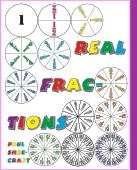 |
 |
|||||||||||||||||
 |
||||||||||||||||||
 |
||||||||||||||||||
 |
 |
|||||||||||||||||
 |
||||||||||||||||



Real Fractions
A booklet of 17 guided discovery activities for the fraction circles.
FREE e-book! Download only from this website.
Think Links: Fractions • Decimals • Percent
Teaching and maintenance activities on fraction-decimal-percent equivalences in a game-like format. Presents decimals and percent as simply other ways of writing, thinking, and talking about the same thing: fractions. Answers to hundreds of equivalences in the activities themselves. Lots of pictures of fractional parts of squares that can be modeled with base 10 blocks to show the connection between fractions, decimals, and percent.
Ideal for small groups and learning centers.
Grades 1-6, 51 pages of reproducible black-line masters with permission to duplicate.
Available only from this website.

Fraction Circles
Needed to teach fractions effectively to elementary school students. Fraction rules do not make sense unless.one can picture fractional parts of things in their mind. Among the models for fractions, circles are the best because the unit is always evident: half a pie is half a pie no matter the size of the pie. In contrast, the unit for rods, squares, or rectangles is arbitrary. For instance, for the Cuisenaire rods, if the purple or 4-rod is the unit, the red or 2-rod is 1/2, but if later the orange or 10-rod is the unit, it is 1/5.
The most distinguishing feature of the fraction circles is that they depict 12 different fractions all the way out to 16ths: 1, 1/2, 1/3, 1/4, 1/5, 1/6, 1/8, 1/9, 1/10, 1/12, 1/15, 1/16. (Sevenths, elevenths, and thirteenths were skipped because 7, 11, and 13 are prime numbers, thus limiting the number of problems that could be solved with them. Fourteenths were skipped because sevenths were skipped.) Having them go out that far allows students to solve lots of problems with them, and the more they solve, the more data (answers) they get from which to deduce the rules that connect the problems to the answers. Also, having 10ths, 15ths, and 16ths, in particular, make the skip counting patterns exhibited by equivalent fractions stand out. Note the equivalences for 1/2 and 2/3:
1/2 = 2/4 = 3/6 = 4/8 = 5/10 = 6/12 = 8/16
2/3 = 4/6 = 6/9 = 8/12 = 10/15
Those for 1/2 are ripe for the question "What fraction is missing in this sequence?" Ans. 7/14, because the top numbers are counting numbers, so there should be a 7 between 6 and 8, and the bottom numbers are the skip counting numbers for 2, so there should be a 14 between 12 and 16.
FREE e-book! Download only from this website.

Math Games & Activities, Vol. 2
Eighty games, activities, worksheets, and instructional aids for all major topics in number, geometry, and measurement in elementary school math. Diagnostic/prescriptive games for whole numbers, fractions, decimals, and percent. A complete program for teaching understanding of arithmetic word problems based on viewing addition, subtraction, multiplication, and division as combining and separating actions.
Answers and more than 100 pages of instructions with lots of examples and illustrations.
Grades 4-9, 322 pages with permission to duplicate.